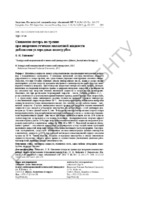| dc.contributor.author | Лабкович, О. Н. | ru |
| dc.coverage.spatial | Минск | ru |
| dc.date.accessioned | 2017-05-17T11:02:43Z | |
| dc.date.available | 2017-05-17T11:02:43Z | |
| dc.date.issued | 2017 | |
| dc.identifier.citation | Лабкович, О. Н. Снижение потерь на трение при вихревом течении магнитной жидкости добавками углеродных нанотрубок = Reduction of Friction Losses due to the Vortex Flow of the Magnetic Fluid Caused by the Additives of Carbon Nanotubes / О. Н. Лабкович // Энергетика. Известия высших учебных заведений и энергетических объединений СНГ. – 2017. – № 3. – С. 265-275. | ru |
| dc.identifier.uri | https://rep.bntu.by/handle/data/29938 | |
| dc.description.abstract | Магнитная жидкость является перспективным смазывающим материалом, например в подшипниках скольжения. С помощью магнитной системы магнитная жидкость удерживается в зазоре трения, что существенно упрощает конструкцию системы смазки. Известно, что при течении обычных смазок (минерального масла, воды) в зазоре между цилиндрами с ростом скорости вращения внутреннего цилиндра происходит переход ламинарного течения в вихревое. При этом резко возрастают потери на вязкое трение. Экспериментально исследованы потери на трение в широком интервале скоростей и возможности их снижения при вихревом течении магнитной жидкости в зазоре между цилиндрами. Выявлено, что при достижении безразмерной скорости – числа Тейлора, равного 41,2, – резко увеличивается угол наклона кривой момента трения, вязкие потери тоже возрастают, т. е. происходит смена ламинарного режима течения на вихревой. Средняя температура в слое магнитной жидкости достигает 60°C. Этот фактор приводит к повышению испарения жидкости-носителя (воды, минерального масла), что снижает ресурс работы смазки – магнитной жидкости. С целью уменьшения вязкого трения при вихревом течении магнитной жидкости в нее вводятся углеродные нанотрубки, представляющие собой цилиндры диаметром до 5,0 нм и длиной около 0,1 мм. Углеродные нанотрубки проявляют упругость при поперечном изгибе: под воздействием нагрузки изгибаются, а после ее снятия восстанавливают первоначальную форму. Они также способны удлиняться вдоль оси на 16 % и после снятия нагрузки возвращаться в исходное положение. Экспериментально получен эффект снижения трения (около 30 %) при вихревом течении магнитной жидкости введением углеродных нанотрубок в магнитные жидкости МНт-40 и МВ-32. Вероятный механизм уменьшения трения – способность нанотрубок деформироваться под воздействием пульсаций давления и скоростей вихревого потока и частично поглощать часть их энергии. Как показали эксперименты, существует оптимальная весовая концентрация добавки нанотрубок в магнитную жидкость (∼10⁻⁴), при которой наблюдается максимальный эффект снижения трения на 30 %. Таким образом, введение углеродных нанотрубок в смазку (магнитную жидкость) позволяет снижать вязкое трение и соответственно увеличивать диапазон рабочих скоростей, повышать ресурс смазочного узла. | ru |
| dc.language.iso | ru | ru |
| dc.publisher | БНТУ | ru |
| dc.subject | Magnetic fluid | en |
| dc.subject | Magnetic field | en |
| dc.subject | Single-layered carbon nanotubes | en |
| dc.subject | Vortex flow | en |
| dc.subject | Магнитная жидкость | ru |
| dc.subject | Магнитное поле | ru |
| dc.subject | Углеродные нанотрубки - однослойные | ru |
| dc.subject | Вихревое течение | ru |
| dc.title | Снижение потерь на трение при вихревом течении магнитной жидкости добавками углеродных нанотрубок | ru |
| dc.title.alternative | Reduction of Friction Losses due to the Vortex Flow of the Magnetic Fluid Caused by the Additives of Carbon Nanotubes | en |
| dc.type | Article | ru |
| dc.relation.journal | Известия высших учебных заведений и энергетических объединений СНГ. Энергетика | ru |
| dc.identifier.doi | 10.21122/1029-7448-2017-60-3-265-275 | |
| local.description.annotation | Magnetic fluids are promising lubricating material, in particular, in sliding bearings. With the aid of the magnetic system the magnetic fluid is held in the gap of friction that simplifies the design of the lubrication system sufficiently. It is known that when conventional lubricants (mineral oil, water) flow, with increasing of speed of rotation of the inner cylinder the transition of laminar flow in a vortex takes place. This dramatically increases the viscous friction losses. The friction losses in a wide range of speeds and possibilities of their decrease due to the vortex flow of the magnetic fluid in the gap between the cylinders are experimentally studied. It is revealed that when the dimensionless speed – number of Taylor equal to 41.2 – is reached, the slope of the curve of friction torque sharply increases, viscous losses also increase, i. e. there is a change laminar flow to a vortex one. The average temperature in the layer of the magnetic fluid reaches 60°C. This factor leads to increased evaporation of the carrier liquid (water, mineral oil), which reduces the service life of the lubricant i.e. the magnetic fluid. In order to reduce viscous friction when a vortex flow of magnetic fluids takes place, carbon nanotubes, which are cylinders with a diameter of 5.0 nm and a length of about 0.1 mm, are brought into the magnetic fluid. Carbon nanotubes demonstrate elasticity under transverse bending: they curve under the impact of load, and after its removal they restore their original shape. They are also able to elongate along the axis by 16 % and to return to its original position after removal of the load. The effect of reducing friction (about 30 %) with a vortex flow of magnetic fluid by the introduction of carbon nanotubes in a magnetic fluid is experimentally obtained. The likely mechanism of friction reduction is the ability of nanotubes to deform under the influence of pressure pulsations and the velocity of the swirling flow, and to absorb partially a part of their energy. As it was experimentally demonstrated, there is an optimum weight concentration of the additive of nanotubes in the magnetic fluid (∼10⁻⁴) that is associated with the maximum effect of reducing friction by 30 %. Thus, the insertion of carbon nanotubes in the lubricant (magnetic fluid) makes it possible to reduce the viscous friction and, consequently, to increase the range of operating speeds, to strengthen the online lubricant site. | en |

